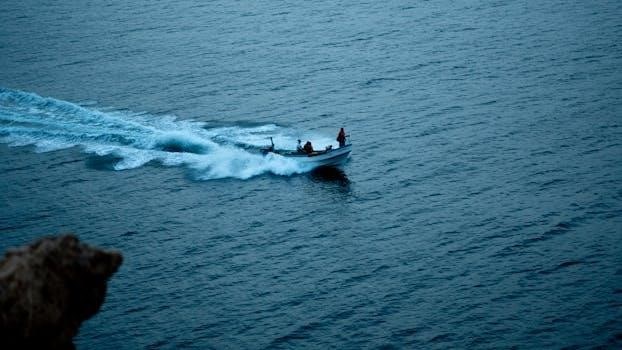Fork Truck Manual⁚ A Comprehensive Guide
Fork truck manuals are essential resources offering detailed specifications‚ operating procedures‚ and maintenance guidelines. They provide crucial safety information‚ ensuring operators understand proper handling and preventive care. These manuals cover various models‚ detailing their unique features and functions‚ promoting safe and efficient operation of the equipment.
Fork truck manuals serve as indispensable guides for the safe and efficient operation of forklifts‚ offering detailed insights into their technical specifications‚ operational procedures‚ and maintenance protocols. These manuals are crucial resources for operators‚ maintenance personnel‚ and safety managers‚ ensuring that all individuals involved in forklift operations have a comprehensive understanding of the equipment. The manuals typically cover various aspects‚ including safety procedures‚ pre-operational checks‚ operational guidelines‚ and troubleshooting common issues. They also provide information on the forklift’s load capacity‚ stability‚ and limitations‚ which are vital for preventing accidents and ensuring safe handling practices. Furthermore‚ fork truck manuals often include detailed instructions on lubrication‚ inspections‚ and repairs‚ promoting the longevity and optimal performance of the equipment. Access to and understanding of these manuals are fundamental for maintaining a safe working environment and complying with industry regulations‚ such as those set by OSHA. Different types of manuals exist‚ including operator manuals‚ service manuals‚ and parts manuals‚ each catering to a specific purpose. Therefore‚ understanding the specific type of manual is crucial for its effective use. These manuals are essential for both new and experienced operators.
Key Components of a Fork Truck Manual
A comprehensive fork truck manual typically includes several key components that are essential for safe and effective operation. Firstly‚ it contains detailed specifications of the forklift‚ such as its model number‚ load capacity‚ dimensions‚ and weight‚ which are crucial for matching the equipment to specific tasks. Secondly‚ the manual provides an overview of the forklift’s structure and working principles‚ clarifying how the different components function together. Safety procedures form a significant section‚ covering pre-operational checks‚ safe operating practices‚ and emergency protocols. These procedures often include instructions on lockout/tagout procedures and proper operator training requirements. Another key element is the operational guidelines‚ which detail the correct procedures for maneuvering‚ lifting‚ and carrying loads‚ emphasizing the importance of avoiding overloading and maintaining stability. Maintenance procedures are also thoroughly explained‚ including daily lubrication checks‚ periodic inspections‚ and repair instructions to ensure the forklift remains in optimal condition. Troubleshooting guides help operators identify and address common issues‚ reducing downtime. Furthermore‚ the manual includes information about the forklift’s data plate‚ a critical resource for understanding its capabilities and limitations. Finally‚ resources for obtaining additional manuals and parts are often included‚ making it a complete reference guide.
Safety Procedures in Fork Truck Operation
Operating a fork truck requires strict adherence to safety procedures to prevent accidents and injuries. Before each use‚ operators must perform thorough pre-operational checks‚ inspecting brakes‚ lights‚ horns‚ and seat belts to ensure they are functioning correctly. The manual emphasizes the importance of maintaining a safe speed and avoiding sudden stops or turns that could lead to instability. Operators are instructed to never exceed the forklift’s load capacity and to always keep loads stable and secure to avoid tipping or dropping. The manual outlines guidelines for safe lifting and lowering of loads‚ stressing the need to avoid tilting forks while raised‚ and to always stop safely if the engine stops. Operators must also be aware of their surroundings‚ keeping a safe distance from pedestrians‚ and using warning devices appropriately. Proper training is essential‚ and the manual underscores the need for operators to be fully familiar with all safety regulations and procedures. In case of a tipover‚ operators are advised to stay with the forklift‚ holding on firmly to the steering wheel and bracing their feet‚ rather than attempting to jump out. The manual also includes instructions on lockout/tagout procedures to ensure the forklift is safely deactivated during maintenance and repairs.
Pre-Operational Checks and Inspections
Before operating a fork truck‚ a comprehensive pre-operational check is crucial to ensure safe and efficient performance. This inspection‚ detailed in the manual‚ should include a visual assessment of the forklift’s overall condition‚ looking for any signs of damage or wear. Specifically‚ operators must check the tires for proper inflation and any cuts or bulges‚ and inspect the forks for cracks‚ bends‚ or wear. The manual directs operators to verify the functionality of all safety devices‚ such as the horn‚ lights‚ and backup alarm‚ ensuring they are in good working order. Brake functionality is paramount; operators should test both the service and parking brakes to ensure they are responsive and reliable. The steering mechanism should be checked for smooth operation and absence of excessive play. Fluid levels‚ including engine oil‚ coolant‚ and hydraulic fluid‚ must be at the recommended levels. Seatbelts should be inspected for proper function and any signs of damage. Additionally‚ the manual often includes specific checklist items pertinent to the particular model‚ such as checking battery connections on electric forklifts. These checks‚ performed before each shift‚ are vital in preventing accidents and maintaining optimal equipment performance‚ as detailed in the fork truck manual.
Operational Guidelines for Fork Trucks
Operating a fork truck safely and effectively requires adherence to specific guidelines outlined in the operator’s manual. These guidelines emphasize the importance of maintaining a safe speed‚ especially when turning or maneuvering in confined spaces‚ to prevent tip-overs. The manual stresses the need to always keep the load stable and centered on the forks‚ avoiding overloading‚ which can lead to instability and accidents. Operators are instructed to avoid tilting the forks while raised‚ as this action increases the risk of load shifting or falling. When moving‚ the forks should be kept low to the ground to improve stability and visibility. The manual also covers proper techniques for approaching and engaging loads‚ ensuring the forks are fully under the pallet or load before lifting. Operators should be aware of their surroundings and maintain a clear line of sight‚ watching out for pedestrians or other obstacles. It is crucial to avoid sudden stops or starts‚ which can cause the load to shift. When parking the forklift‚ the operator must lower the forks to the ground‚ engage the parking brake‚ and turn off the engine. The manual provides detailed instructions on handling specific load types and navigating different work environments‚ ensuring operators can perform their duties safely and efficiently. These guidelines are crucial for preventing accidents‚ optimizing performance and prolonging the life of the equipment.
Maintenance Procedures for Fork Trucks
Regular maintenance is essential for ensuring the reliable and safe operation of fork trucks‚ as detailed in their respective manuals. These procedures typically encompass daily‚ weekly‚ and monthly checks‚ focusing on key components. Daily maintenance includes inspecting fluid levels such as engine oil‚ coolant‚ and hydraulic fluid‚ ensuring they are within the recommended ranges. Operators should also check the tires for proper inflation and any signs of wear or damage. The manual emphasizes the importance of lubricating moving parts as directed‚ which reduces friction and prevents premature wear. Weekly maintenance often involves a more thorough inspection‚ including checking the brakes‚ steering‚ and lift mechanisms for any malfunctions or abnormalities. The battery terminals and cables on electric forklifts should also be inspected for corrosion or loose connections. The manual provides specific instructions for tightening bolts‚ adjusting belts‚ and replacing filters as needed. Monthly checks may include a more detailed analysis of the engine or motor‚ transmission‚ and other internal components. Regular cleaning is also important‚ removing accumulated dirt‚ debris‚ and grease that could affect performance or cause safety hazards. The manual stresses the importance of keeping detailed records of all maintenance activities‚ including the date‚ service performed‚ and any parts replaced. This documentation helps track the overall health of the equipment and allows for timely intervention when necessary. Adhering to these maintenance procedures will prolong the life of the fork truck and ensure safe operation.
Troubleshooting Common Fork Truck Issues
Fork truck manuals include sections dedicated to troubleshooting common problems‚ providing operators and maintenance personnel with guidance on diagnosing and resolving issues. A frequent problem is a failure to start‚ which could be due to a dead battery‚ faulty ignition system‚ or low fuel levels‚ detailed within the manual’s troubleshooting section. Another common issue is a loss of lifting power‚ which might stem from hydraulic system leaks‚ low fluid levels‚ or a malfunctioning pump‚ all typically covered in the manual. The manual also addresses issues related to steering‚ such as difficult turning or excessive play‚ which could result from loose steering components or a lack of lubrication. Braking problems‚ including weak or ineffective brakes‚ are often included in the manual‚ with instructions for inspection and adjustment. Unusual noises or vibrations during operation can also indicate underlying problems‚ such as worn bearings or loose parts. The manual guides users through checking for these issues‚ advising on when professional assistance is required. Overheating is a concern that is also covered‚ often indicating a problem with the cooling system. The troubleshooting section of the manual typically includes a step-by-step process for identifying issues‚ which may involve visual inspections‚ testing components‚ and referring to diagrams. It stresses the importance of not attempting repairs beyond one’s expertise and seeking trained technicians for complex problems. The manual also includes information on how to properly reset error codes and indicator lights that may appear during operation. By utilizing the manual’s troubleshooting guide‚ operators and technicians can address many issues‚ minimizing downtime and ensuring the continued safe operation of the fork truck.
Importance of Operator Training
Operator training is paramount for the safe and efficient operation of fork trucks‚ and it is often emphasized in the fork truck manual. Proper training ensures that operators are aware of the risks associated with operating these machines and that they are competent in utilizing them. Untrained operators pose a significant safety hazard‚ leading to accidents‚ injuries‚ and damage to equipment and property. Comprehensive training programs cover a variety of topics‚ including the proper use of controls‚ safe load handling techniques‚ and pre-operational inspections. The training also educates operators on the specific limitations and capabilities of the fork truck‚ as well as environmental factors that may affect operation. Furthermore‚ operator training ensures that operators are familiar with the safety procedures and emergency protocols outlined in the manual. Effective training programs typically include both classroom instruction and hands-on practice‚ allowing operators to develop practical skills and knowledge. It is important that operators are trained on the specific model of fork truck they will be using‚ as different models may have unique operating characteristics and safety requirements. Regular refresher training is also essential to reinforce best practices and keep operators up-to-date on any changes in safety regulations or procedures. The fork truck manual often serves as a key resource during training‚ providing a reference guide for operators to consult throughout their careers. By investing in thorough operator training‚ companies can significantly reduce the risk of accidents‚ promote a safer workplace‚ and improve productivity. Certified training programs should include practical assessments to verify that each operator is competent before being allowed to operate a fork truck unsupervised. Proper training reduces the probability of misuse and ensures compliance with OSHA regulations‚ which are frequently highlighted within the manual.
OSHA Requirements for Forklift Operation
OSHA‚ the Occupational Safety and Health Administration‚ sets forth specific regulations for forklift‚ or powered industrial truck‚ operation‚ which are often referenced within the fork truck manual. These requirements are designed to ensure worker safety and prevent accidents. While OSHA doesn’t specifically mandate that an operator manual be present on the forklift‚ it does require employers to develop and implement a comprehensive training program for all forklift operators. This training must include formal instruction‚ practical exercises‚ and an evaluation of the operator’s performance. The training must cover topics such as operating procedures‚ pre-shift inspections‚ load handling‚ and the safe use of the forklift in specific work environments. Employers must also certify that each operator has been properly trained and evaluated‚ and that they are competent to operate a forklift safely. OSHA regulations also address the proper maintenance and inspection of forklifts. Employers are responsible for ensuring that all forklifts are in safe operating condition‚ with regular inspections‚ repairs‚ and maintenance completed as recommended by the manufacturer‚ often outlined in the manual. Additionally‚ OSHA requires that forklifts are used only for their intended purpose and within their rated capacity. Overloading or misuse of forklifts can lead to tip-overs and other dangerous situations. OSHA standards also address environmental concerns‚ such as operating forklifts in areas with potentially hazardous substances. Furthermore‚ OSHA requires employers to maintain records of operator training and forklift maintenance. The fork truck manual serves as a critical resource for understanding and complying with OSHA requirements‚ and it is essential for both employers and operators to be familiar with these regulations. Compliance with OSHA guidelines is not only a legal obligation but also a crucial component of a safe and productive work environment. The manual should clarify these regulations for the specific truck model.
Understanding Forklift Data Plates
The forklift data plate‚ a critical component often referenced in the fork truck manual‚ provides vital information about a specific forklift’s capabilities and limitations. This plate is permanently affixed to each forklift and serves as a quick reference guide for operators and maintenance personnel. The data plate typically includes the manufacturer’s name‚ the forklift model number‚ and the serial number‚ which are essential for identifying the machine and accessing the correct manual. It also specifies the forklift’s weight‚ the maximum load capacity‚ and the load center‚ providing essential information for safe operation. Understanding the load capacity is paramount to prevent overloading‚ which can lead to tip-overs and severe accidents. The data plate also often includes information on the lift height‚ and the mast type‚ which is crucial for matching the forklift to the specific tasks it will perform. The type of fuel used by the forklift‚ whether it’s electric‚ diesel‚ propane or gasoline‚ may also be listed. Additionally‚ some data plates show the tire sizes and types‚ which is important for maintaining stability and proper ground clearance. The data plate may also include information on the forklift’s attachments‚ if any‚ and the maximum weight of the attachments it can safely handle. The data plate also indicates whether the forklift is rated for indoor or outdoor use‚ or both. Operators should be trained on how to read and interpret the data plate and should always refer to it before operating any forklift. The information on the data plate should be cross-referenced with the information in the operator’s manual. A clear understanding of the data plate ensures the forklift is operated correctly and safely‚ promoting both productivity and accident prevention. It is also important to check the data plate regularly to ensure that it is legible and has not been altered or damaged‚ as any discrepancies can lead to dangerous situations.
Resources for Fork Truck Manuals
Types of Fork Truck Manuals
Fork truck manuals come in several types‚ each designed to serve a specific purpose and audience. The most common is the operator’s manual‚ which provides essential information for the safe and efficient operation of the forklift. This manual details pre-operational checks‚ safe driving practices‚ and basic maintenance guidelines. Then‚ there is the service manual‚ which is more technical‚ geared towards trained mechanics and service technicians‚ offering detailed instructions on repairs‚ maintenance‚ and troubleshooting. It includes exploded diagrams‚ wiring schematics‚ and torque specifications. Parts manuals‚ another type‚ list all the components of the forklift with their corresponding part numbers‚ which are essential for ordering replacements. There are also safety manuals‚ which focus solely on safety procedures and best practices‚ including lockout/tagout and other safety protocols. Some manufacturers also provide training manuals‚ which guide instructors in delivering comprehensive training programs for forklift operators. Some manuals cover specific types of forklifts‚ such as rough terrain forklifts‚ truck-mounted forklifts‚ or electric forklifts‚ while others cover an entire series of models. In addition‚ some manuals are intended for specific audiences‚ such as equipment management personnel‚ who need information on maintenance schedules‚ or training program developers. The format of manuals can also vary‚ with some available in printed form‚ while many are now accessible as PDFs or through online portals. It is crucial to use the correct manual for the specific model and purpose. Using the wrong manual can lead to errors‚ damage‚ or unsafe practices. Therefore‚ it is essential to know the different types of manuals and to use them appropriately. Understanding the different types of manuals‚ their intended use and target audience ensures that the appropriate information is accessible when needed‚ promoting safe and efficient operations and maintenance.
























